A Multi-Data Geospatial Approach for Understanding Flood Risk in the Coastal Plains of Tamil Nadu, India
Abstract
:1. Introduction
2. Materials and Methods
2.1. Study Area
2.2. Flood Hazard Mapping
2.3. Surface Runoff Potential
2.4. Vulnerability Assessment
2.5. Field Survey
2.6. Validation of Flood Hazard
2.7. Assessment of Built-Up Elements at Flood Risk
3. Results
3.1. Hazard Analysis
3.2. Surface Runoff Potential
3.3. Vulnerability Assessment
3.4. Perceptions of Deprived Communities
3.5. Assessment of Built-Up Elements at Flood Risk
4. Discussion
5. Conclusions and Scope for Future Research
Supplementary Materials
Author Contributions
Funding
Institutional Review Board Statement
Informed Consent Statement
Data Availability Statement
Acknowledgments
Conflicts of Interest
References
- Tsakiris, G. Flood risk assessment: Concepts, modelling, applications. Nat. Hazards Earth Syst. Sci. 2014, 14, 1361–1369. [Google Scholar] [CrossRef] [Green Version]
- Balica, S.F.; Wright, N.G.; van der Meulen, F. A flood vulnerability index for coastal cities and its use in assessing climate change impacts. Nat. Hazards 2012, 64, 73–105. [Google Scholar] [CrossRef] [Green Version]
- Khan, A.; Chatterjee, S. Coastal Risk Assessment: A Comprehensive Framework for the Bay of Bengal; Springer: Cham, Switzerland, 2018; ISBN 9783319699929. [Google Scholar]
- Small, C.; Nicholls, R.J. A global analysis of human settlement in coastal zones. J. Coast. Res. 2003, 19, 584–599. [Google Scholar]
- Suriya, S.; Mudgal, B.V.; Nelliyat, P. Flood damage assessment of an urban area in Chennai, India, part I: Methodology. Nat. Hazards 2012, 62, 149–167. [Google Scholar] [CrossRef]
- Dhar, O.N.; Nandargi, S. Hydrometeorological aspects of floods in India. Nat. Hazards 2003, 28, 1–33. [Google Scholar] [CrossRef]
- Singh, Y.T.; Das, R.R.; Kumar, D.S.V.; Krishnan, P.; Ramachandran, P.; Ramachandran, R. Rapid assessment of coastal biodiversity post-2015 chennai flood, India. EnvironmentAsia 2019, 12, 91–103. [Google Scholar] [CrossRef]
- Winsemius, H.C.; Van Beek, L.P.H.; Jongman, B.; Ward, P.J.; Bouwman, A. A framework for global river flood risk assessments. Hydrol. Earth Syst. Sci. 2013, 17, 1871–1892. [Google Scholar] [CrossRef] [Green Version]
- Ahmed, C.F.; Kranthi, N. Flood vulnerability assessment using geospatial techniques: Chennai, India. Indian J. Sci. Technol. 2018, 11, 1–13. [Google Scholar] [CrossRef] [Green Version]
- Uddin, K.; Matin, M.A.; Meyer, F.J. Operational flood mapping using multi-temporal Sentinel-1 SAR images: A case study from Bangladesh. Remote Sens. 2019, 11, 1581. [Google Scholar] [CrossRef] [Green Version]
- Joshi, P.M. Urban flood mapping by geospatial technique a case study of surat city. IOSR J. Eng. 2012, 2, 43–51. [Google Scholar] [CrossRef]
- Singh, A.K.; Sharma, A.K. GIS and a remote sensing based approach for urban flood-plain mapping for the Tapi catchment, India. IAHS-AISH Publ. 2009, 331, 389–394. [Google Scholar]
- Patel, D.; Dholakia, M. Identifying probable submergence area of surat city using digital elevation model and geographical information system. World Appl. Sci. J. 2010, 9, 461–466. [Google Scholar]
- Zope, P.E.; Eldho, T.I.; Jothiprakash, V. Impacts of urbanisation on flooding of a coastal urban catchment: A case study of Mumbai City, India. Nat. Hazards 2015, 75, 887–908. [Google Scholar] [CrossRef]
- Demirkesen, A.C.; Evrendilek, F.; Berberoglu, S.; Kilic, S. Coastal flood risk analysis using landsat-7 ETM+ imagery and SRTM DEM: A case study of Izmir, Turkey. Environ. Monit. Assess. 2007, 131, 293–300. [Google Scholar] [CrossRef]
- Van de Sande, B.; Lansen, J.; Hoyng, C. Sensitivity of coastal flood risk assessments to digital elevation models. Water 2012, 4, 568–579. [Google Scholar] [CrossRef]
- Ehrlich, D.; Melchiorri, M.; Florczyk, A.J.; Pesaresi, M.; Kemper, T.; Corbane, C.; Freire, S.; Schiavina, M.; Siragusa, A. Remote sensing derived built-up area and population density to quantify global exposure to five natural hazards over time. Remote Sens. 2018, 10, 1378. [Google Scholar] [CrossRef] [Green Version]
- Jariwala, R.C.; Samtani, B.K. The estimation of flood and its control by section modification in Mithi and Kankara tributaries at Surat. Int. J. Eng. Res. Appl. 2012, 2, 862–867. [Google Scholar]
- Padhee, S.K.; Nikam, B.R.; Dutta, S.; Aggarwal, S.P. Using satellite-based soil moisture to detect and monitor spatiotemporal traces of agricultural drought over Bundelkhand region of India. GISci. Remote Sens. 2017, 54, 144–166. [Google Scholar] [CrossRef]
- Kvočka, D.; Falconer, R.A.; Bray, M. Flood hazard assessment for extreme flood events. Nat. Hazards 2016, 84, 1569–1599. [Google Scholar] [CrossRef] [Green Version]
- Papathoma-Köhle, M.; Schlögl, M.; Fuchs, S. Vulnerability indicators for natural hazards: An innovative selection and weighting approach. Sci. Rep. 2019, 9, 15026. [Google Scholar] [CrossRef]
- Singh, S.R.; Eghdami, M.R.; Singh, S. The concept of social vulnerability: A review from disasters perspectives. Int. J. Interdiscip. Multidiscip. Stud. 2014, 1, 71–82. [Google Scholar]
- UNISDR. 2009 UNISDR Terminology on Disaster Risk Reduction; UNISDR: Geneva, Switzerland, 2009. [Google Scholar]
- De Brito, M.M.; Evers, M.; Delos Santos Almoradie, A. Participatory flood vulnerability assessment: A multi-criteria approach. Hydrol. Earth Syst. Sci. 2018, 22, 373–390. [Google Scholar] [CrossRef] [Green Version]
- Bahinipati, C.S.; Rajasekar, U.; Acharya, A.; Patel, M. Flood-induced loss and damage to textile industry in Surat City, India. Environ. Urban ASIA 2017, 8, 170–187. [Google Scholar] [CrossRef]
- Xia, J.; Falconer, R.A.; Lin, B.; Tan, G. Numerical assessment of flood hazard risk to people and vehicles in flash floods. Environ. Model. Softw. 2011, 26, 987–998. [Google Scholar] [CrossRef]
- Karuppusamy, B.; Leo George, S.; Anusuya, K.; Venkatesh, R.; Thilagaraj, P.; Gnanappazham, L.; Kumaraswamy, K.; Balasundareshwaran, A.H.; Balabaskaran Nina, P. Revealing the socio-economic vulnerability and multi-hazard risks at micro-administrative units in the coastal plains of Tamil Nadu, India. Geomat. Nat. Hazards Risk 2021, 12, 605–630. [Google Scholar] [CrossRef]
- Prasad, K.A.; Ottinger, M.; Wei, C.; Leinenkugel, P. Assessment of coastal aquaculture for India from Sentinel-1 SAR time series. Remote Sens. 2019, 11, 357. [Google Scholar] [CrossRef] [Green Version]
- Long, S.; Fatoyinbo, T.E.; Policelli, F. Flood extent mapping for Namibia using change detection and thresholding with SAR. Environ. Res. Lett. 2014, 9, 035002. [Google Scholar] [CrossRef]
- Clement, M.A.; Kilsby, C.G.; Moore, P. Multi-temporal synthetic aperture radar flood mapping using change detection. J. Flood Risk Manag. 2018, 11, 152–168. [Google Scholar] [CrossRef]
- Brocca, L.; Liersch, S.; Melone, F.; Moramarco, T.; Volk, M. Application of a model-based rainfall-runoff database as efficient tool for flood risk management. Hydrol. Earth Syst. Sci. 2013, 17, 3159–3169. [Google Scholar] [CrossRef] [Green Version]
- Elfeki, A.; Masoud, M.; Niyazi, B. Integrated rainfall–runoff and flood inundation modeling for flash flood risk assessment under data scarcity in arid regions: Wadi Fatimah basin case study, Saudi Arabia. Nat. Hazards 2017, 85, 87–109. [Google Scholar] [CrossRef]
- Verma, S.; Verma, R.K.; Mishra, S.K.; Singh, A.; Jayaraj, G.K. A revisit of NRCS-CN inspired models coupled with RS and GIS for runoff estimation. Hydrol. Sci. J. 2017, 62, 1891–1930. [Google Scholar] [CrossRef]
- Balasubramani, K. Physical resources assessment in a semi-arid watershed: An integrated methodology for sustainable land use planning. ISPRS J. Photogramm. Remote Sens. 2018, 142, 358–379. [Google Scholar] [CrossRef]
- Balasubramani, K.; Gomathi, M.; Bhaskaran, G.; Kumaraswamy, K. GIS-based spatial multi-criteria approach for characterization and prioritization of micro-watersheds: A case study of semi-arid watershed, South India. Appl. Geomat. 2019, 11, 289–307. [Google Scholar] [CrossRef]
- Cutter, S.L.; Mitchell, J.T.; Scott, M.S. Revealing the vulnerability of people and places: A case study of Georgetown County, South Carolina. Hazards Vulnerabil. Environ. Justice 2012, 90, 83–114. [Google Scholar] [CrossRef]
- Mohapatra, R. Community Based Planning in Post-Disaster Reconstruction: A Case Study of Tsunami Affected Fishing Communities in Tamil Nadu Coast of India. Ph.D. Thesis, University of Waterloo, Waterloo, ON, Canada, 2009. [Google Scholar]
- Unal, I. Defining an optimal cut-point value in ROC analysis: An alternative approach. Comput. Math. Methods Med. 2017, 2017, 3762651. [Google Scholar] [CrossRef] [PubMed]
- Avand, M.; Moradi, H.R.; Lasboyee, M.R. Spatial prediction of future flood risk: An approach to the effects of climate change. Geoscience 2021, 11, 25. [Google Scholar] [CrossRef]
- Sepehri, M.; Malekinezhad, H.; Hosseini, S.Z.; Ildoromi, A.R. Assessment of flood hazard mapping in urban areas using entropy weighting method: A case study in Hamadan city, Iran. Acta Geophys. 2019, 67, 1435–1449. [Google Scholar] [CrossRef]
- Ehrlich, D.; Kemper, T.; Pesaresi, M.; Corbane, C. Built-up area and population density: Two Essential Societal Variables to address climate hazard impact. Environ. Sci. Policy 2018, 90, 73–82. [Google Scholar] [CrossRef] [PubMed]
- Dobson, J.E.; Bright, E.A.; Coleman, P.R.; Durfee, R.C.; Worley, B.A. Landscan: A global piopulation database for estimating populations at risk. Photogramm. Eng. Remote Sens. 2000, 66, 849–857. [Google Scholar]
- Hallegatte, S.; Green, C.; Nicholls, R.J.; Corfee-Morlot, J. Future flood losses in major coastal cities. Nat. Clim. Chang. 2013, 3, 802–806. [Google Scholar] [CrossRef]
- Merz, B.; Elmer, F.; Thieken, A.H. Significance of “high probability/low damage” versus “low probability/high damage” flood events. Nat. Hazards Earth Syst. Sci. 2009, 9, 1033–1046. [Google Scholar] [CrossRef]
- Merz, B.; Kreibich, H.; Schwarze, R.; Thieken, A. Review article “assessment of economic flood damage”. Nat. Hazards Earth Syst. Sci. 2010, 10, 1697–1724. [Google Scholar] [CrossRef]
- De, U.S.; Dube, R.K.; Prakasa Rao, G.S. Extreme weather events over india in the last 100 years. J. Indian Geophys. Union 2005, 9, 173–187. [Google Scholar]
- Sudha Rani, N.N.V.; Satyanarayana, A.N.V.; Bhaskaran, P.K. Coastal vulnerability assessment studies over India: A review. Nat. Hazards 2015, 77, 405–428. [Google Scholar] [CrossRef]
- Mahendra, R.S.; Mohanty, P.C.; Bisoyi, H.; Kumar, T.S.; Nayak, S. Assessment and management of coastal multi-hazard vulnerability along the Cuddalore-Villupuram, east coast of India using geospatial techniques. Ocean Coast. Manag. 2011, 54, 302–311. [Google Scholar] [CrossRef]
- Ramasamy, S.M.; Vijay, A.; Dhinesh, S. Geo-anthropogenic aberrations and Chennai floods: 2015, India. Nat. Hazards 2018, 92, 443–477. [Google Scholar] [CrossRef]
- Anandan, C.; Sasidhar, P. Changes in coastal morphology at Kalpakkam, East Coast, India due to 26 december 2004 Sumatra tsunami. Geomat. Nat. Hazards Risk 2011, 2, 183–192. [Google Scholar] [CrossRef]
- Sheik Mujabar, P.; Chandrasekar, N. Coastal erosion hazard and vulnerability assessment for southern coastal Tamil Nadu of India by using remote sensing and GIS. Nat. Hazards 2013, 69, 1295–1314. [Google Scholar] [CrossRef]
- Mani Murali, R.; Ankita, M.; Amrita, S.; Vethamony, P. Coastal vulnerability assessment of Puducherry coast, India, using the analytical hierarchical process. Nat. Hazards Earth Syst. Sci. 2013, 13, 3291–3311. [Google Scholar] [CrossRef] [Green Version]
- Muthusankar, G.; Lakshumanan, C.; Pradeep-Kishore, V.; Eswaramoorthi, S.; Jonathan, M.P. Classifying inundation limits in SE coast of India: Application of GIS. Nat. Hazards 2013, 65, 2401–2409. [Google Scholar] [CrossRef]
- Gopinath, G.; Løvholt, F.; Kaiser, G.; Harbitz, C.B.; Srinivasa Raju, K.; Ramalingam, M. Bhoop singh impact of the 2004 Indian Ocean tsunami along the Tamil Nadu coastline: Field survey review and numerical simulations. Nat. Hazards 2014, 72, 743–769. [Google Scholar] [CrossRef]
- Kaliraj, S.; Chandrasekar, N.; Magesh, N.S. Evaluation of coastal erosion and accretion processes along the southwest coast of Kanyakumari, Tamil Nadu using geospatial techniques. Arab. J. Geosci. 2015, 8, 239–253. [Google Scholar] [CrossRef]
- Parthasarathy, A.; Natesan, U. Coastal vulnerability assessment: A case study on erosion and coastal change along Tuticorin, Gulf of Mannar. Nat. Hazards 2015, 75, 1713–1729. [Google Scholar] [CrossRef]
- Priya Rajan, S.M.; Nellayaputhenpeedika, M.; Tiwari, S.P.; Vengadasalam, R. Mapping and analysis of the physical vulnerability of coastal Tamil Nadu. Hum. Ecol. Risk Assess. 2020, 26, 1879–1895. [Google Scholar] [CrossRef]
- Thirumurugan, P.; Krishnaveni, M. Flood hazard mapping using geospatial techniques and satellite images—A case study of coastal district of Tamil Nadu. Environ. Monit. Assess. 2019, 191, 193. [Google Scholar] [CrossRef] [PubMed]
- Huang, C.; Chen, Y.; Wu, J. Mapping spatio-temporal flood inundation dynamics at large riverbasin scale using time-series flow data and MODIS imagery. Int. J. Appl. Earth Obs. Geoinf. 2014, 26, 350–362. [Google Scholar] [CrossRef]
- Mohammadi, A.; Costelloe, J.F.; Ryu, D. Application of time series of remotely sensed normalised difference water, vegetation and moisture indices in characterising flood dynamics of large-scale arid zone floodplains. Remote Sens. Environ. 2017, 190, 70–82. [Google Scholar] [CrossRef]
- Manavalan, R.; Rao, Y.S.; Mohan, B.K. Comparative flood area analysis of C-band VH, VV, and L-band HH polarisations SAR data. Int. J. Remote Sens. 2017, 38, 4645–4654. [Google Scholar] [CrossRef]
- Adelekan, I.O. Vulnerability of poor urban coastal communities to flooding in Lagos, Nigeria. Environ. Urban. 2010, 22, 433–450. [Google Scholar] [CrossRef] [Green Version]
- Brouwer, R.; Akter, S.; Brander, L.; Haque, E. Socioeconomic vulnerability and adaptation to environmental risk: A case study of climate change and flooding in Bangladesh. Risk Anal. 2007, 27, 313–326. [Google Scholar] [CrossRef] [PubMed] [Green Version]
- Svetlana, D.; Radovan, D.; Ján, D. The Economic impact of floods and their importance in different regions of the world with emphasis on Europe. Procedia Econ. Financ. 2015, 34, 649–655. [Google Scholar] [CrossRef] [Green Version]
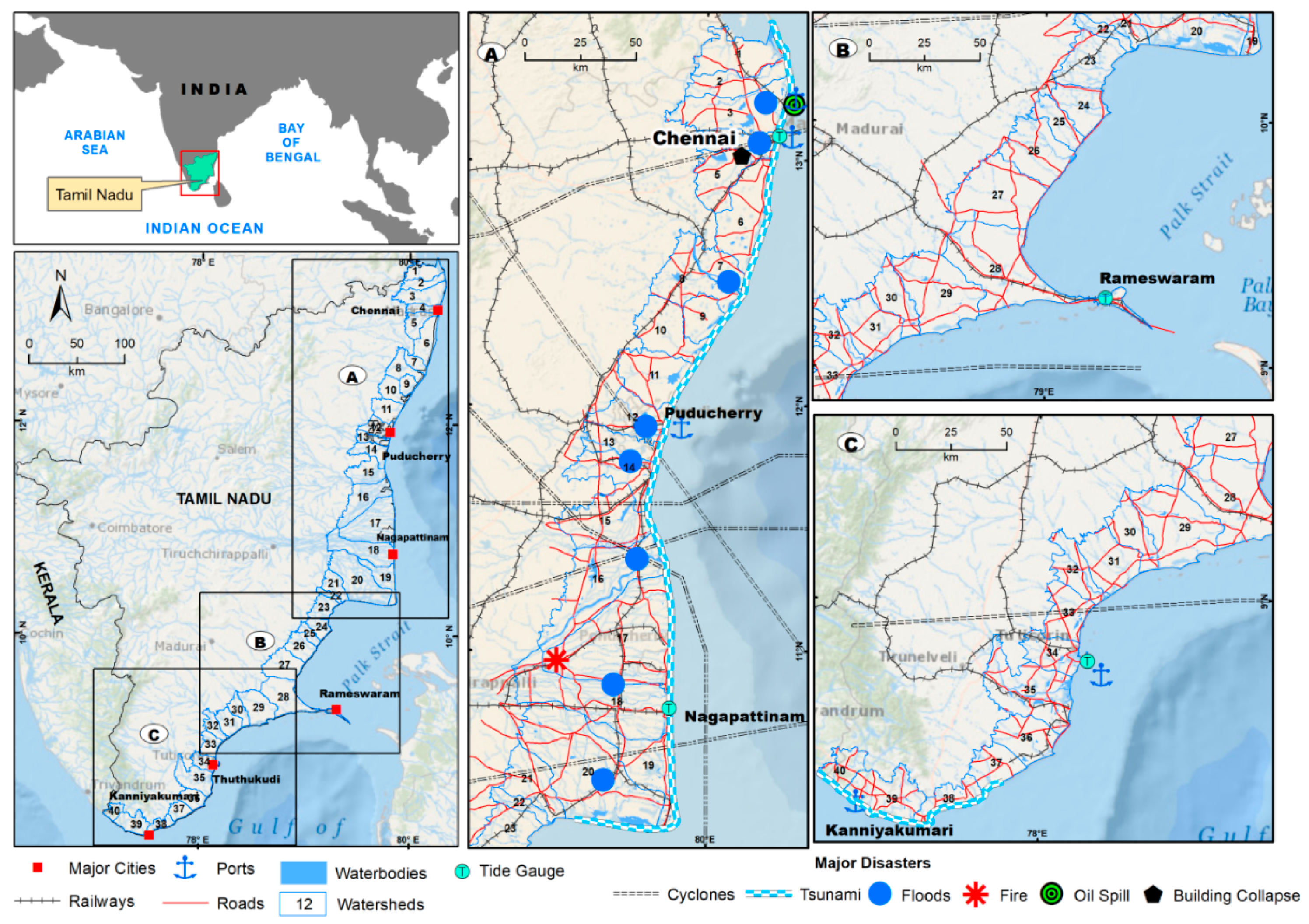
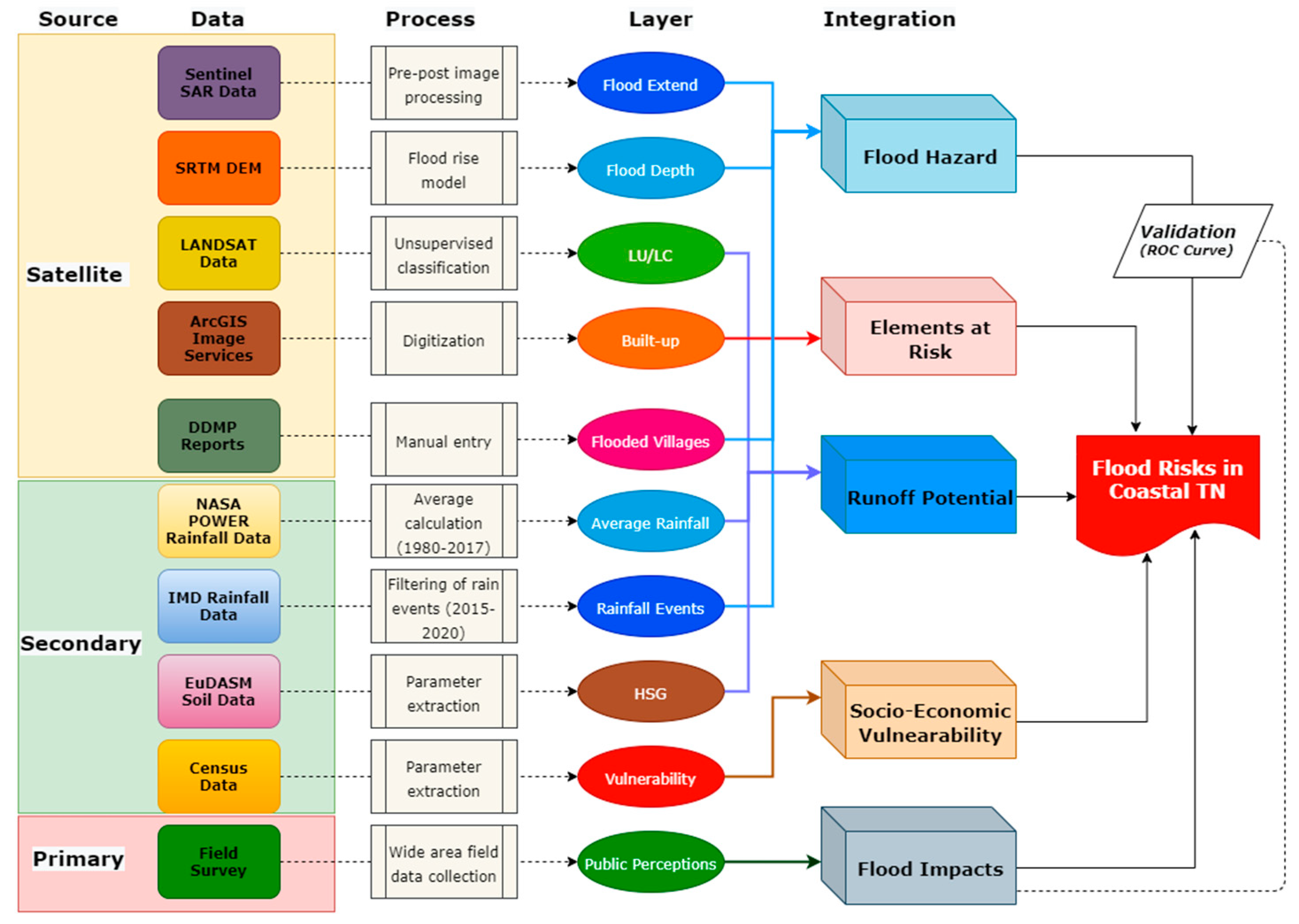
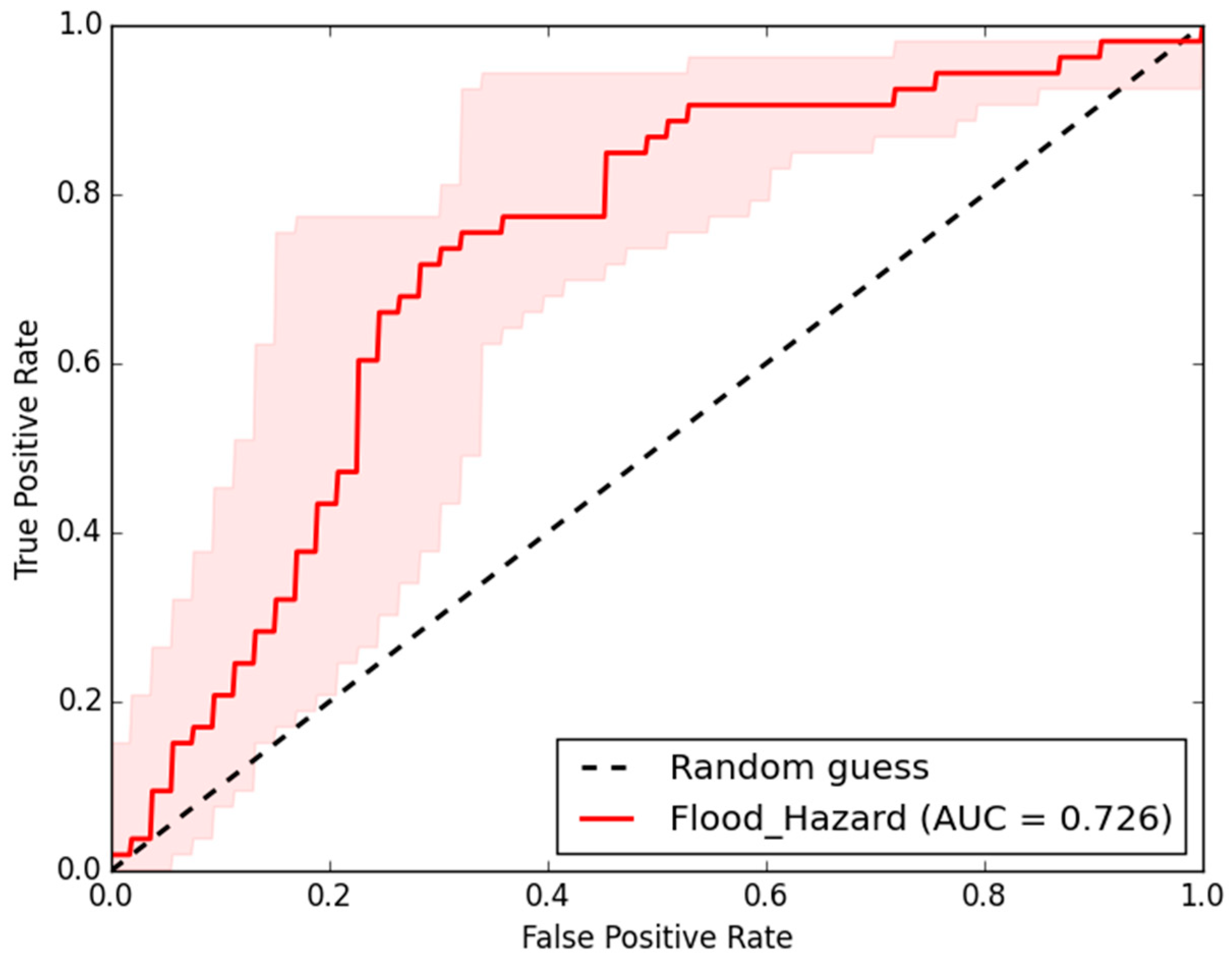

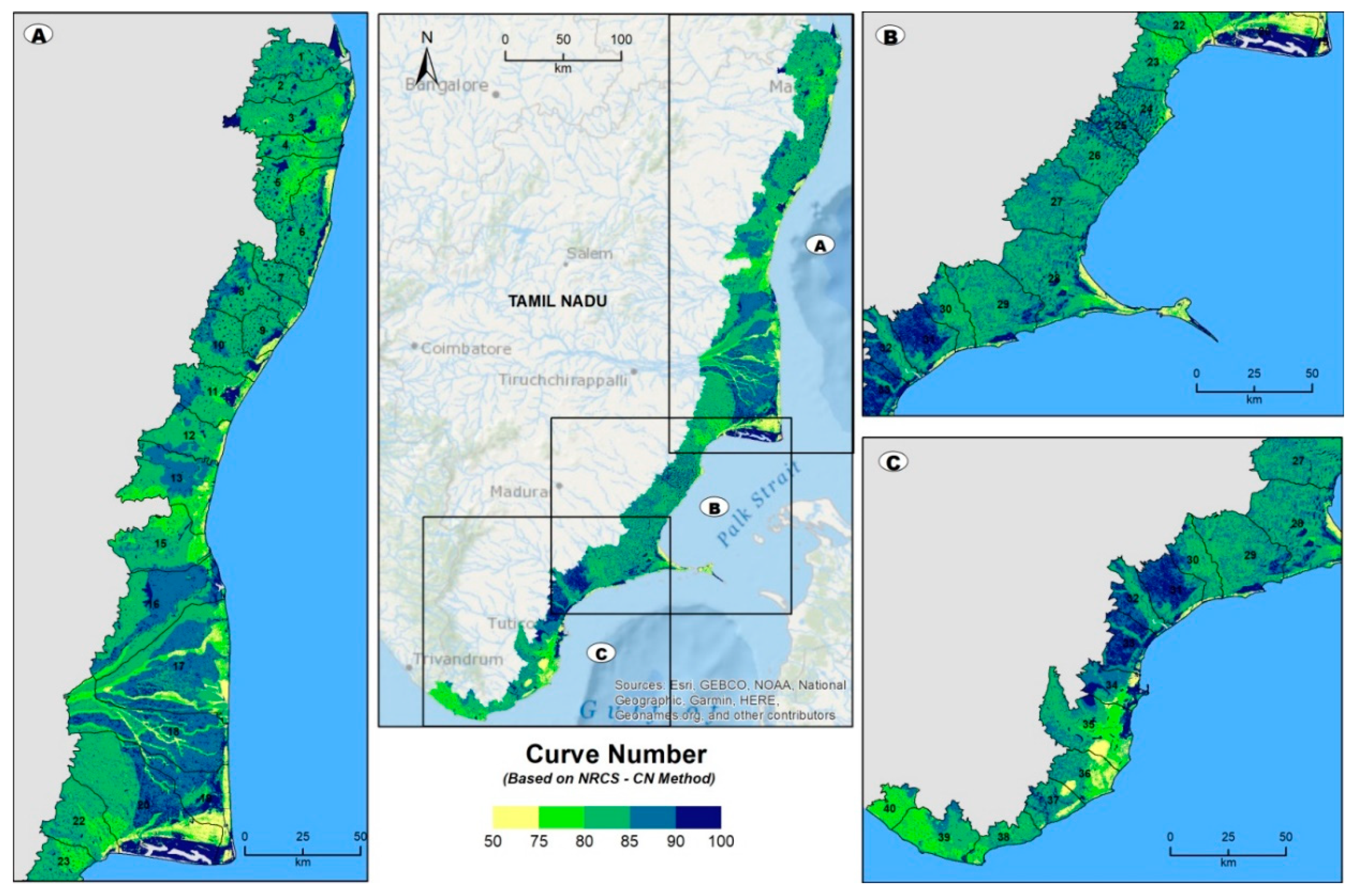

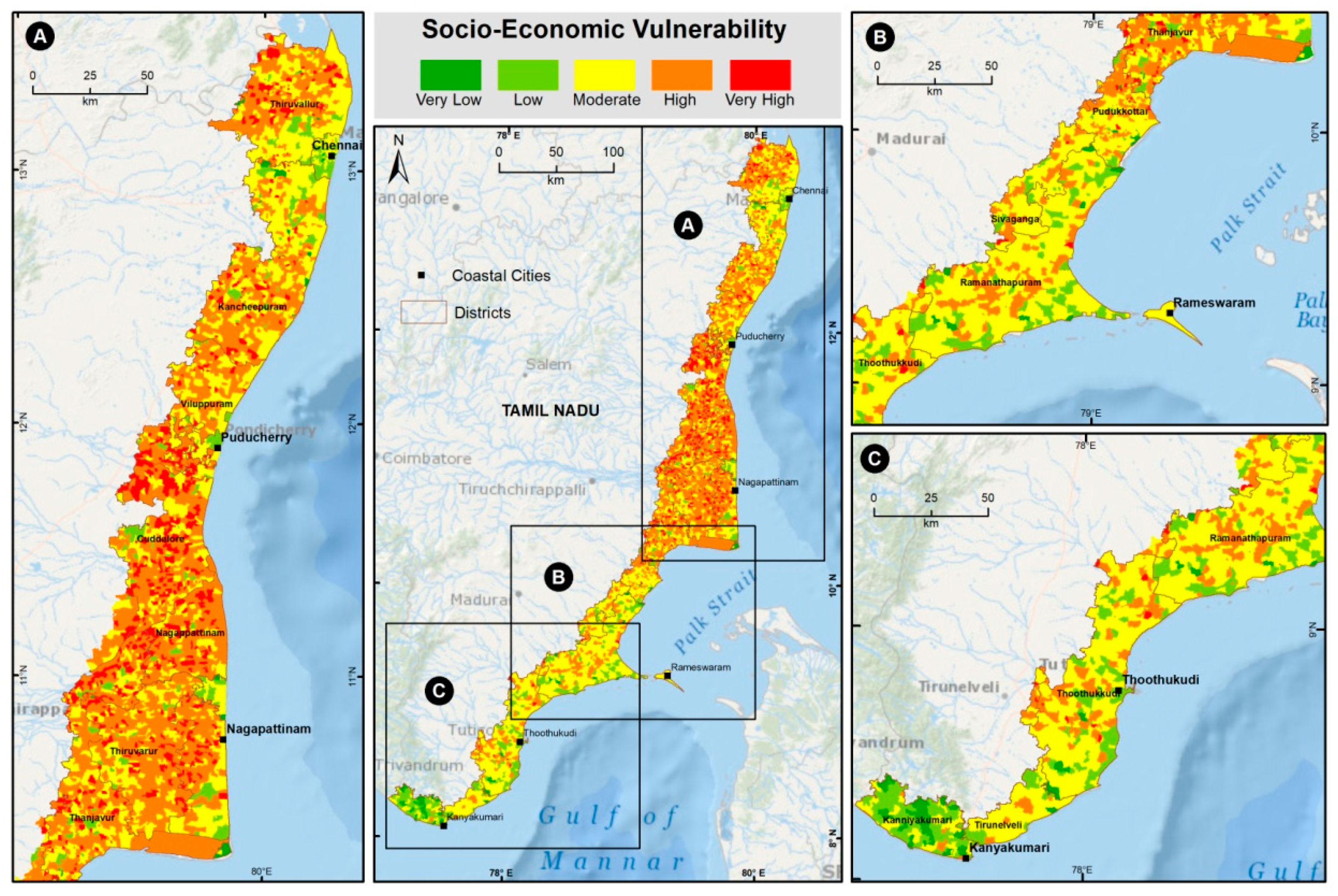
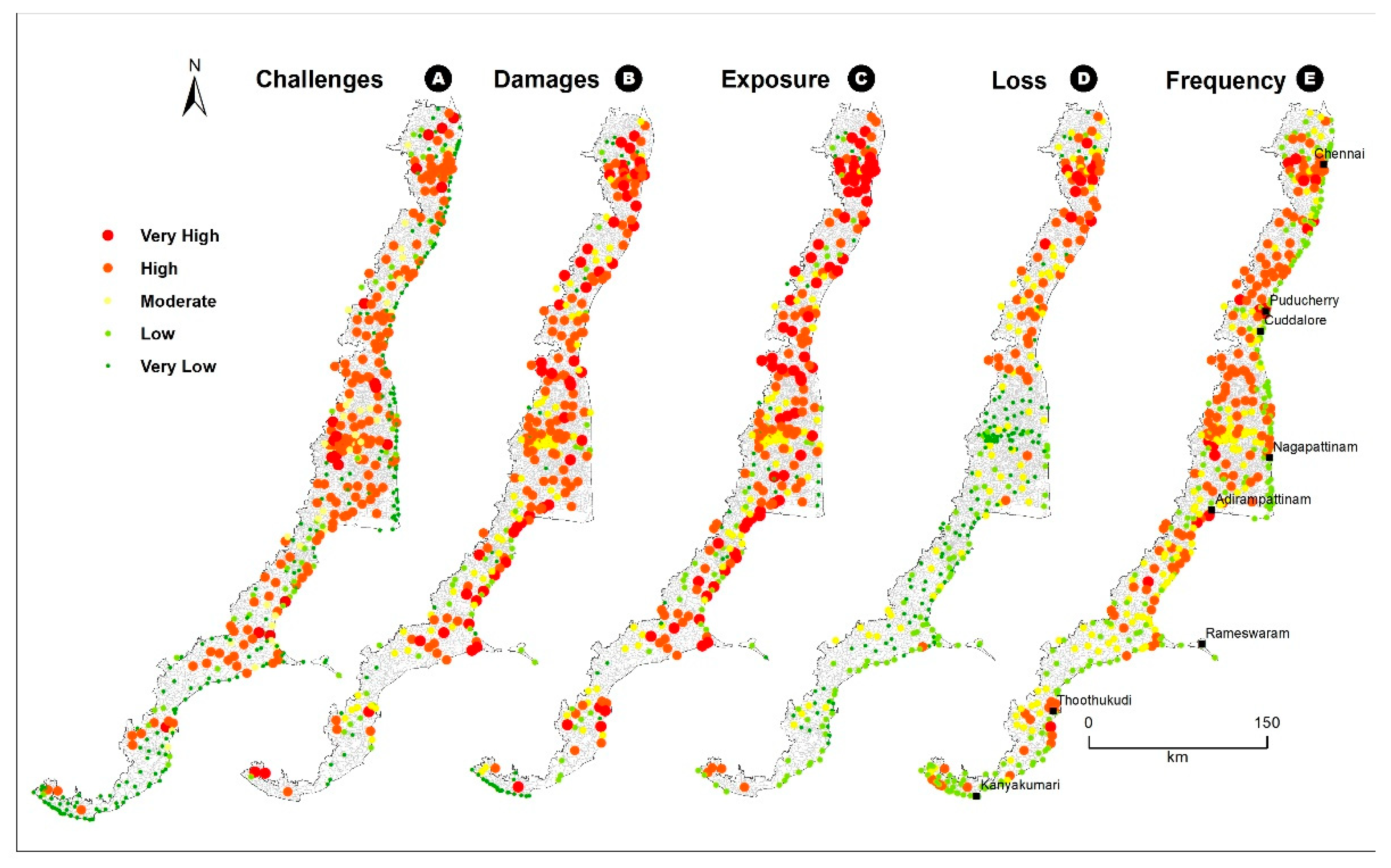


| Year | Before Flood | After Flood |
|---|---|---|
| 2015 | 10 October 2015 to 23 October 2015 | 10 November 2015 to 15 December 2015 |
| 2018 | 10 October 2018 to 23 October 2018 | 01 November 2018 to 18 December 2018 |
| 2020 | 10 November 2020 to 23 November 2020 | 24 November 2020 to 10 December 2020 |
| 2020–2021 | 10 November 2020 to 23 November 2020 | 06 January 2021 to 17 January 2021 |
| 2021 | 1 May 2021 to 20 May 2021 | 27 May 2021 to 02 June 2021 |
| 2021 | 1 October 2021 to 20 October 2021 | 16 November 2021 to 26 November 2021 |
| Categories | Sub-Categories |
|---|---|
| Population Density | Total Population |
| Household density | Total Households |
| Female Population Ratio | Total Female Population |
| Child Population Ratio | Total Child Population (0–6 Years) |
| Literacy Rate | Total Literacy Population |
| Socially Weaker Population | Scheduled Castes Population Scheduled Tribes Population |
| Primary Workers | Main Cultivators Main Agricultural Labours Marginal Cultivators Marginal Agricultural Labours |
| Sanitation Facilities | Tap Water Treated Community Toilet Complex Community Waste Disposal System |
| Communication Facilities Access to Essential Healthcare Facilities | Telephone Mobile Phone Coverage Public Bus Service Community Health Center Primary Health Center Health Sub-Centre Maternity and Child Welfare Center Hospital Allopathic (including district/taluk headquarter hospitals) Hospital Alternative Medicine Dispensary and Family Welfare Center |
| Risk Index | Relative Risk Level | Built-Up Area (sq. km) | % Share to Total Built-Up Area |
|---|---|---|---|
| >0.61 | Very high | 107.17 | 4.26 |
| 0.51–0.6 | High | 106.73 | 4.25 |
| 0.31–0.5 | Moderate | 245.5 | 9.77 |
| 0.21–0.3 | Low | 222.63 | 8.86 |
| <0.2 | Very Low | 167.26 | 6.66 |
Publisher’s Note: MDPI stays neutral with regard to jurisdictional claims in published maps and institutional affiliations. |
© 2022 by the authors. Licensee MDPI, Basel, Switzerland. This article is an open access article distributed under the terms and conditions of the Creative Commons Attribution (CC BY) license (https://creativecommons.org/licenses/by/4.0/).
Share and Cite
George, S.L.; Kantamaneni, K.; V, R.A.; Prasad, K.A.; Shekhar, S.; Panneer, S.; Rice, L.; Balasubramani, K. A Multi-Data Geospatial Approach for Understanding Flood Risk in the Coastal Plains of Tamil Nadu, India. Earth 2022, 3, 383-400. https://doi.org/10.3390/earth3010023
George SL, Kantamaneni K, V RA, Prasad KA, Shekhar S, Panneer S, Rice L, Balasubramani K. A Multi-Data Geospatial Approach for Understanding Flood Risk in the Coastal Plains of Tamil Nadu, India. Earth. 2022; 3(1):383-400. https://doi.org/10.3390/earth3010023
Chicago/Turabian StyleGeorge, Sekar Leo, Komali Kantamaneni, Rasme Allat V, Kumar Arun Prasad, Sulochana Shekhar, Sigamani Panneer, Louis Rice, and Karuppusamy Balasubramani. 2022. "A Multi-Data Geospatial Approach for Understanding Flood Risk in the Coastal Plains of Tamil Nadu, India" Earth 3, no. 1: 383-400. https://doi.org/10.3390/earth3010023
APA StyleGeorge, S. L., Kantamaneni, K., V, R. A., Prasad, K. A., Shekhar, S., Panneer, S., Rice, L., & Balasubramani, K. (2022). A Multi-Data Geospatial Approach for Understanding Flood Risk in the Coastal Plains of Tamil Nadu, India. Earth, 3(1), 383-400. https://doi.org/10.3390/earth3010023












